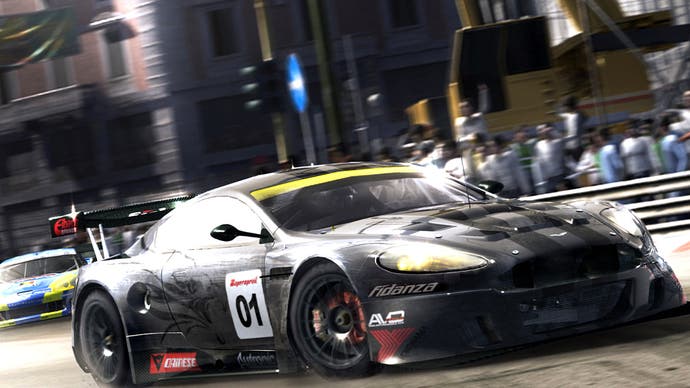Race Driver: GRID
Project go team!
On our visit to Codemasters' HQ to see the reboot of the track racing series formally known as TOCA, one other game keeps coming up in conversation. That game is Project Gotham Racing 4, and it's not just the journos bringing it up. Codies developers are generous enough to praise PGR4's beauty, its structure, its weather effects, its difficulty balancing. Watching an Aston DBR9 tear around sunlit Milan esplanades and neon-lit Shibuya alleyways - and, later, feeling a certain credible but forgiving slide in the handling, when we go hands-on - it seems that the influence of Bizarre's brilliant series runs deep and wide in GRID.
"I think that's fair," says chief game designer Ralph Fulton of the certainly quite flattering comparison. "In terms of the arcade-to-simulation spectrum, I guess we're inhabiting a fairly similar space at the moment. And we're comfortable with that, because that's where we set out to go in the first place."
Seeing Race Driver close in on PGR gives rise to genuinely mixed feelings. Codies' admiration for Gotham is easy to share: its effortless poise, rich variety and note-perfect pitch between stern sim challenge and arcade thrill make it close to the perfect racer, so why not emulate that? But we also had a deep fondness for TOCA's real motorsport setting and tight, aggressive, wheel-to-wheel touring car racing. Sadly, Fulton reveals that Codemasters felt that TOCA was, conceptually, on a hiding to nothing.

"We reached a stage with the TOCA franchise where we'd hit a ceiling with the number of people to whom we could sell that type of content. It certainly does not appeal broadly in the United States, hence unit sales in single digits for previous TOCA games over there," he confesses. "We make no bones about it, corporately, that we want to make the American market as important as our European market. If that sounds clinical, then I guess that's just the way the games industry is at the moment. But I don't think the people who traditionally love touring cars and open-wheel racing will be disappointed, because you can still do those things in this game as well. And we still use the AI and the physics which have made those games really successful."
The result is an edgy new title and look, a smattering of glamorous city tracks, the complete removal of any setup, modification or tuning from the game, and a move to mostly fictional, unlicensed motorsport series. This is still a game about racing cars, though - with the exception of a hands-on session with a classic Boss Mustang, we don't see a single production model. And it's very much a game about racing. Once you squeeze past the Gotham-sized elephant in the room, you'll discover that GRID is a game with a lot of interesting and unique tricks up its sleeve - especially with regard to its team system.
The career mode is based around racing in three regions - America, Europe and Asia (Japan) - through three tiers of competition, and across a number of different disciplines: stock muscle cars, GTs, touring cars, Le Mans series sports cars, open-wheel racing and, intriguingly, the Japanese drift scene. You begin as a driver for hire, but you'll eventually be spending your winnings on setting up your own team - buying cars, establishing a racing livery (a simple one - no Forza paint editors here), seeking sponsorship from real brands to stick on your car, and, most crucially, hiring an AI team mate. Progress is earned through a combination of money and reputation, with your sponsors setting specific goals for each race.

It's all about bringing the racing experience to the fore, says Fulton. "The team idea is a way of getting the player to feel involved at a really basic level - by making him buy the cars, by making him hire the team-mate that races with him, by leading him to forge rivalries with other drivers.
"So a crash isn't just a crash, it's a crash that involved his worthless team-mate. I'm not ashamed that there's a little bit of soap opera in that, because there is in real life. For me, last year's Formula One season was the first one for a decade where it had all those things." There's even a pit radio system (although there are no pit stops), and recordings of hundreds of first names and nicknames, so you could quite easily have your own name shouted at you when you take the lead.
Alongside Milan and the stunningly-lit Shibuya - the Neon engine used in Colin McRae DiRT is really flexing its muscles now, and there's no doubt that GRID is a gorgeous game - Washington and San Francisco will appear in the US section. The Asian tracks include a fictional Grand Prix circuit, and a couple of locations that reflect the illegal street-racing scene - a drift track at the deserted Yokohama docks, and the famous Haruna mountain road from the Initial D film (complete with oncoming traffic).


.png?width=291&height=164&fit=crop&quality=80&format=jpg&auto=webp)




.jpg?width=291&height=164&fit=crop&quality=80&format=jpg&auto=webp)
